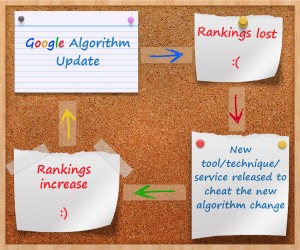 In late July Google quietly made a change to its Unnatural Links Document that has spawned articles claiming that Google has killed PR and it’s now Google vs. PR. What’s interesting about this update is that it seemingly sprawls outside of the SEO community and hits PR. In the past, the webmaster updates and algorithm changes were big but didn’t really influence another marketing tactic or service. Why this “link scheme” update might be a big one for PR is because within this update three highly used tactics in the PR world are getting targeted. Guest Posts, Press Releases and Advertorials (Paid Content).
In late July Google quietly made a change to its Unnatural Links Document that has spawned articles claiming that Google has killed PR and it’s now Google vs. PR. What’s interesting about this update is that it seemingly sprawls outside of the SEO community and hits PR. In the past, the webmaster updates and algorithm changes were big but didn’t really influence another marketing tactic or service. Why this “link scheme” update might be a big one for PR is because within this update three highly used tactics in the PR world are getting targeted. Guest Posts, Press Releases and Advertorials (Paid Content).
At its core Google’s goal is to provide it’s users with the best and most relative content related to their search query. When methods exist to manipulate the search rankings Google tries to put a stop to it. Just as hidden text on a site and directory links worked to enhance rankings, Google is now taking a stand on how links are crafted in some common PR tactics.
Why do links matter to begin with?
Top ranking websites in Google are relevant to the search at hand (on-site optimization) and “popular.” Google measures a website’s popularity by the quality and quantity of links back to a website. So, if you want to rank in Google you need links built to your website’s content. Over time many SEO’s and PR Pros develop specific strategies and tactics to specifically grow this back link profile to help enhance a website’s ranking. And that’s exactly what Google doesn’t like.
If you are relying on Guest Posts, Press Releases or Advetorials (Paid Content) as link building strategies Google might have it out for you as “Any links intended to manipulate a site’s ranking in Google search results may be considered part of a link scheme and a violation of Google’s Webmaster Guidelines.” Here’s some insight into the link scheme update.
Guest Posts According to Google
“The following are examples of link schemes which can negatively impact a site’s ranking in search results:Large-scale article marketing or guest posting campaigns with keyword-rich anchor text links”
My recommendation: This is tough as “large-scale” means absolutely nothing. How large is large-scale? To begin with, if you are using guest posts make sure that the content you are giving away is good quality content. Google and users like good content. Secondly, I wouldn’t totally remove keyword-rich anchor text links, I just wouldn’t go overboard with the links or use the same anchor text or landing pages in each guest post. The goal here is to keep the guest posts looking as natural as possible and 1-2 links in an article is seemingly natural. However, if you are worried you could always keep the links and avoid using keyword-rich anchor text… or give links the no-follow attribute.
Press Releases According to Google
For example:
There are many wedding rings on the market. If you want to have a wedding, you will have to pick the best ring. You will also need to buy flowers and a wedding dress.”
My recommendation: Well, the example provide from Google is very link heavy and spammy, if that’s how you’ve been crafting your releases its time for a different approach. If you want to keep all of those links you can but make sure the links utilize the no-follow attribute. Personally I’d dial back the amount of links in the release as well. We have no idea how strict Google will stay with this but having a keyword rich anchor text link in a release will now be a roll of the dice. Frank Strong from Sword and the Script has a few good recommendations for the new press release.
Paid Content According to Google
My recommendation: Be honest and disclose that this is a paid piece of content and make sure that links are not followed as nobody likes to be deceived. However how does Google know that the content has been purchased? I guess you can be sneaky but if Google finds out you might get penalized.
What’s this no-follow attribute?
Within the code of a hyperlink you have the ability to tell Google not to follow the link. This means that the search engine bot will not follow the link therefore not influencing ranking for that page or term. Users can still click the link and seamlessly be able to view content.
Key Takeaways
SEO’s saw some big changes with the Panda and Penguin algorithm changes and now some PR tactics are getting pulled into the Google mix. Really what this all boils down to is excellent and engaging content. If you have great content and you’re using PR to promote the content Google wants to make sure that you aren’t adversely influencing their rankings with the links in your promotions. If you want to drive traffic with the above tactics and you want to be safe, make sure the no-follow attribute is used on links. I also agree with Jason Kintzler says and these Google updates might just be a good thing.
Image from Warrior Forum
